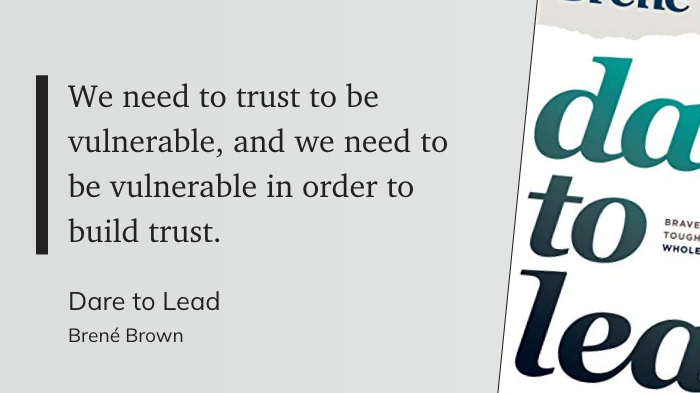
“We need to trust to be vulnerable, and we need to be vulnerable in order to build trust.”
Brené Brown, Dare to Lead
Trust and vulnerability are two essential elements for a productive and effective learning environment. In schools, teachers, coaches, and administrators must establish trust with their students and colleagues to achieve academic success. Trust is a crucial element in creating a positive and safe learning environment. It can be defined as the firm belief in the reliability, truth, or ability of someone or something. When teachers trust their students, they provide them with the freedom to take risks and make mistakes without fear of judgment. Vulnerability, on the other hand, is the quality or state of being exposed to the possibility of being attacked or harmed, either physically or emotionally. When teachers are vulnerable with their students, they create a connection that can lead to more profound learning experiences.
Why Teachers Must Trust Students and Be Vulnerable
Establishing trust with students is critical in creating a positive and safe learning environment. When teachers trust their students, they provide them with the freedom to take risks and make mistakes without fear of judgment. Students who feel trusted are more likely to take academic risks, which can lead to deeper learning experiences. Trust also allows students to feel comfortable sharing their thoughts and feelings, which can help teachers better understand their students’ needs and respond accordingly.
A student who trusts their teacher is optimistic that the teacher will act in a certain way even though the student does not know whether the teacher will do so. If the student knew that this would occur, no trust would be necessary. The intriguing thing about trust is that it makes us rely on other people without knowing whether this reliance is warranted. We often find ourselves in situations in which trust is needed. This is also true for students at school. In many cases, students do not know whether what the teacher teaches is worth knowing. They simply trust that the teacher will select relevant content and appropriate learning methods for their lessons. Also, when it comes to testing their intellectual competences what they have learnt in class, students trust that the teacher will provide them with helpful and encouraging feedback, that the teacher will not make fun of their errors and that the teacher will recognise the effort and progress that the students have made.
Monika Platz, Trust Between Teacher and Student in Academic Education at School
Additionally, teachers who are vulnerable with their students create a connection that can lead to more profound learning experiences. By sharing their own experiences and struggles, teachers can help students understand that it is okay to make mistakes and that learning is a process.
Your students need to see you struggle. They need to know that it’s ok not to know everything. When I’m visiting classrooms, the number one idea I try to convey to students is that it’s perfectly fine not to get “it” right on the first try. There is a benefit to the productive struggle.
This can help students develop a growth mindset, where they believe that they can improve their abilities through hard work and dedication.
The Significance of Teachers Trusting Other Teachers
Trusting other teachers is crucial in building a strong professional community. In a school setting, teachers should be able to rely on each other for support, brainstorming, and collaboration. When teachers trust each other, they are more likely to share ideas and resources, and they can provide each other with constructive feedback. This collaboration can lead to improved teaching practices, increased student engagement, and, ultimately, better academic outcomes.
When teachers trust other teachers, they are more likely to seek out feedback and support. When the #observeme movement began, it was all about teachers being open and vulnerable with each other. It wasn’t some teachers believing that they had it all together and were experts.
They genuinely wanted feedback from their peers. You can’t get better professional learning than this. Peer-to-peer feedback is a huge boost to your teaching practice.
Whether teachers are working on instruction, developing curriculum, or discussing students, they value the opportunity to collaborate. In our school, the literacy coach held periodic workshops with teachers from all departments. These volunteer workshops focused on different techniques and were always full. Teachers saw the workshops as an opportunity to work with colleagues from other departments and to learn new strategies and protocols. In an atmosphere of trust, they were willing to take the risks that new learning requires. Once teachers experienced the value of this kind of collaboration, they began to use the new strategies in their own classrooms with their students.
Jane Modoono, The Trust Factor
Vulnerability can lead to a culture of continuous improvement, where teachers are constantly looking for ways to improve their practice. This can lead to better academic outcomes for students, as teachers constantly seek to improve their teaching practices.
The Importance of Coaches and Administrators Trusting Teachers and Being Vulnerable
Coaches and administrators play a vital role in creating a culture of trust and vulnerability within a school. When coaches and administrators trust their teachers, they give them the autonomy to make decisions that benefit their students. This can lead to a sense of empowerment among teachers, which can lead to better academic outcomes for students.
Additionally, when coaches and administrators are vulnerable with their teachers, they create a space where teachers can share their thoughts and feelings without fear of repercussions. I am the first person to admit I don’t have all my ish together at times. Especially when trying something new. I’m learning right alongside the teachers and students I work with most of the time. Communicating your own faults opens so many doors with others.
This communication can lead to improved teaching practices, increased teacher satisfaction, and, ultimately, better academic outcomes. When coaches and administrators are vulnerable, they demonstrate that it is okay to make mistakes and that learning is a process. This can lead to a culture of continuous improvement, where teachers are constantly seeking to improve their teaching practices.
Conclusion
In conclusion, trust and vulnerability are essential components of a productive and effective learning environment. Teachers must establish trust with their students and be vulnerable to create a safe and positive learning environment. Trusting other teachers is critical in building a strong professional community, while coaches and administrators must trust teachers and be vulnerable to create a culture of open communication and collaboration. By prioritizing trust and vulnerability in schools, we can create an environment where everyone can learn and grow together.
As educators, it is our responsibility to create a culture of trust and vulnerability in our schools. By doing so, we can create an environment where students feel safe to take academic risks, and teachers feel empowered to improve their teaching practices. When prioritizing trust and vulnerability, we can create an environment where everyone can learn and grow together.
Thanks for taking the time to read this post. If you’ve enjoyed the insights and stories, consider showing your support by subscribing to my weekly newsletter. It’s a great way to stay updated and dive deeper into my content. Alternatively, if you love audiobooks or want to try them, click here to start your free trial with Audible. Your support in any form means the world to me and helps keep this blog thriving. Looking forward to connecting with you more!




